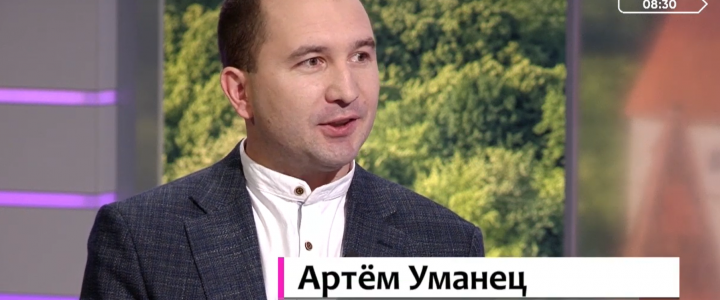Eesti ettevõtte RIA.com Marketplaces’i asjatundjad käisid hiljuti termopildistamas Tallinna hooneid. Termokaamera objektiivi sattusid mitmed tuntud ehitised: Stenbocki majast Superministeeriumini. ETV+ hommikuprogrammis kõneleb katsest ettevõtte juhatuse liige Artjom Umanets. Miks Tallinna tuntud hooned kaotavad kõige rohkem soojust?
– – Kuidas tuli teil mõte selline katse läbi viia ja jalutada mööda Tallinna linna koos termokaameraga?
– – Soojuseenergia kokkuhoid ja soojuskadu on väga päevakajaline teema igal pool maailmas. Teeme tihedat koostööd Ukraina kinnisvaraarendajatega, sest meil on üks suurimaid kinnisvara projekte ligi 45-miljonilise elanikkonnaga riigis: DOM.RIA.com. Meile pakkus huvi viia läbi sarnane uuring ka kodulinnas Tallinnas.
Saatejuht Andrei Titov näitab Stenbocki maja pilti, mis on tehtud termokaameraga.
– – Mida võib öelda sellest hoonest, mis on ehitatud juba 1792. aastal?
– – See hoone on rohkem kui 200 aastat vana. Kontrolli käigus nägime, et hoone kaotab soojust põhiliselt aknaavade, katuse ja, ei ole välistatud, et ka vahelae kaudu.
– Aga kui võib küsida, miks see maja laseb sooja läbi? Millest see sõltub? Kas ehitusmaterjalidest, millest maja on ehitatud?
– Kahtlemata sõltub väga palju ehitusmaterjalidest. Kuid tähtis on ka ehitustehnoloogia. Muide, ka praegu on üpris palju kaasaegseid hooneid, mille soojuskadu on tohutult suur.
Järgmisena näitab saatejuht pilti hotellist „Telegraaf“.
– Hotell „Telegraaf“ tähistas just hoone 141. sünnipäeva. Kui suur soojuskadu on siin?
– Siin tekib samuti põhiline kadu läbi akende. Kuid nähtavasti on siin kvaliteetne sise- ja välisviimistlus. Seinad hoiavad sooja ja kadu on minimaalne. Sama ei saa öelda naabruses olevatest hoonetest.
Saatejuht Andrei Titov küsib ka akende kohta.
– Tänapäeval on moes maast laeni aknad. Kuid aknaid peetakse kõige suuremaks soojuskao põhjuseks. Kas see on tõsi?
– On küll. Aga peab arvestama sellega, et on olemas energiasäästlikuid aknaid, mis tagavad nii piisava valguse läbilaskmise kui ka minimaalse soojuskao.
Ekraanile tuleb pilt Superministeeriumist, mis sai valmis alles 2017. aastal.
– Siin me näeme, et soojuskadu on vastuvõetaval tasemel. Kuigi seda on ikkagi märgata tänu klaasist ehitatud välisseintele. Sellele vaatamata aitab hoone energiasäästlikkus säästa sadu tuhandeid eurosid aastas.
Järgmine hoone ekraani peal on „Radisson“ hotell.
– On näha, et hoone hoiab soojust küllalt hästi. Kollast värvi, mis tähendab soojuskadu peaaegu ei ole. Kas see on nii?
– Jah. Põhiline soojuskadu tuleb hotelli fuajee ja trepikäikude kaudu. Samas hoiavad hotellitoad sooja väga hästi. Sama ei saa öelda hotelliga külgnevate hoonete kohta.
– – Miks suutis hotell teie arvamusel jõuda nii minimaalse soojuskao tasemeni?
– Ma arvan, et peamine põhjus on ilmtingimata ehitustehnoloogia, ehitusmaterjalide ja viimistluse kvaliteet.
Saatejuht Jelena Solomina küsib, mida peaksid teadma korteriomanikud.
– Me räägime nüüd Tallinna kõige tihedamini asustatud linnaosadest, kus inimesed elavad enamasti paneelmajades. Kui ma tahaksin oma korterit soojustada, kas ma pean seda tegema seda omaette või on hoopis mõistlikum soojustada tervet maja?
– Enamikel juhtudel on parem võtta terviklik lahendus, kuid siin mängib rolli ka naabrite nõusolek maksta selle eest.
– – Paljud inimesed, kes elavad soojustatud paneelmajades räägivad sellest, et kodus ei ole õhku. Kas põhjuseks on vigane ehitustehnoloogia või sellist nähtust näeb igal pool paneelmajades?
– See on eelkõige ehitustehnoloogia viga. Miks? Maja soojustamist on vaja vaadelda tervikuna. Sama tähtsad on nii soojusisolatsioon kui ka küte ja ventilatsioon. Majas võib olla hea soojusisolatsioon, kuid puudub korralik ventilatsioon, siis jääb niiskus majja sisse. Soovitaksin alustada akende vahetamisest, kui seda on vaja, ja siis jätkata seinte soojustamisega.



